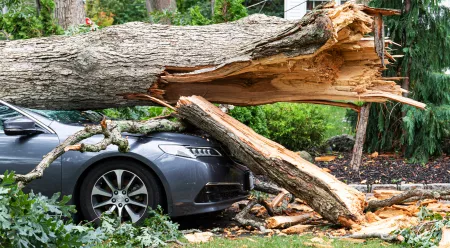There's no denying that getting into a car accident is a stressful and trying event. You don't know how severe the physical or material damage is until the dust settles.
However, after you've collected yourself, you need to assess the situation at hand. If you've recently been involved in a car accident that you didn't cause, you may be eligible for direct compensation for property damage coverage. If you're not familiar with direct compensation property damage, it's in your best interest to continue reading.
START A QUOTE
Knowing when and how to use this type of insurance can potentially save you time and energy down the line.
What is direct compensation property damage insurance?
For those that don't know, direct compensation property damage coverage (often shortened to DCPD insurance) is a type of mandatory insurance for drivers in Ontario. DCPD is also available in the following provinces:
- Quebec
- New Brunswick
- Nova Scotia
- Prince Edward Island
For the majority of the article, we'll be focusing on DCPD in Ontario.
If you're involved in a collision that you're not responsible for, you are eligible for direct financial compensation from your auto insurance provider (hence the name). This allows you to save time and bypass several claim-related hurdles (we'll touch on that again shortly).
How does direct compensation property damage coverage work?
Now that you have a general understanding of direct compensation property damage coverage, it's time to learn how it works.
After a car accident occurs, insurance adjusters are responsible for determining who is "at fault". This is an insurance term that refers to the driver that caused the accident or collision. "Fault" is usually scored from one to 100; if there is any fault allotted at all (as determined by the insurance adjuster), 0 equals 100%. So, the claim will be considered at-fault and rated as such.
How is fault determined after an accident occurs?
This is an interesting and challenging question to answer.
There are numerous variables that insurance adjusters use to determine who is responsible for a car accident. However, one of the primary aspects that they consider is "negligence".
Negligence is a term that, in this case, refers to a driver who didn't act responsibly and, in turn, put themselves or others in potential danger.
Some common examples of negligence on the road include the following:
- Not using headlights properly
- Impaired driving (under the influence of drugs or alcohol)
- Exceeding the speed limit (particularly in school zones and neighbourhoods)
- Distracted driving (texting, talking on the phone, etc.)
Insurance companies use a guideline called Insurance Fault Determination Rules. The Fault Rules have several basic conditions. These conditions specify that insurance companies have to use them when determining fault and that circumstances like weather or road conditions do not matter when determining which driver was responsible.
Benefits of direct compensation property damage coverage
As mentioned above, using direct compensation property damage coverage allows you to work directly with your insurance provider. No matter the fault, a customer still has to submit the claim to their personal insurance company to have their vehicle fixed.
Furthermore, you won't have to undergo any legal procedures in order to get remuneration — instead, you'll receive prompt payment from your provider. In turn, you can spend less time dealing with legal battles, which gives you more time to repair or look for a vehicle.
Required criteria related to direct compensation property damage coverage
After getting into a car accident that you weren't responsible for, you can't automatically assume that you're eligible for direct compensation property damage coverage in Ontario.
There are specific requirements that need to be met in order to be eligible for coverage. These requirements are:
Not at-fault
As mentioned earlier, the insurance adjuster must determine that you're not responsible for the accident.
Number of vehicles involved
In order to be eligible for coverage, there needs to be at least one other vehicle involved in the accident.
Insurance
All parties involved in the accident must have valid auto insurance.
Location of the accident
As mentioned earlier, this type of auto coverage is only available in select provinces, including Ontario. Because of this, the accident needs to have taken place in Ontario or one of the provinces mentioned above and the other driver must also be insured in one of these provinces.
Are there any exemptions related to direct compensation for property damage?
Yes, drivers in Ontario should be aware of a handful of exemptions: hit and runs and collisions with uninsured drivers.
Hit and runs
For those that don't know, a hit and run is a term that describes an accident in which the responsible party flees the scene prior to the insurance adjusters' arrival. Performing a hit and run has several consequences, including the loss of auto insurance privileges.
Due to the fact that the third-party is unidentifiable, the insurance adjuster cannot contact their insurance provider (if they have one). In turn, you cannot rely on your direct compensation property damage insurance.
Instead, drivers in Ontario must submit a collision claim.
Collisions with uninsured driver
As mentioned above, one of the requirements for direct compensation property damage insurance is that all involved parties have valid auto insurance.
This begs the question, what if one (or more) of the parties are uninsured? You can submit a claim under the uninsured automobile portion of your auto insurance policy if this happens.
Do you have to pay a direct compensation property damage deductible?
Another great question! However, the answer isn't straightforward.
In Ontario, there generally is no deductible directly related to direct compensation property damage insurance unless you have specifically requested one to lower your overall insurance premium.
But, this doesn't mean that this fantastic type of coverage comes without a cost.
If you're deemed partially at-fault, you will likely be responsible for covering an equal percentage from your regular auto insurance deductible.
Here's a simple example:
You get into a car accident, and the insurance adjusters deem you 15% at fault. If your standard auto insurance deductible is $750, you have to pay 15% ($112.50) before receiving coverage from your insurance provider.
So, even though there isn't a deductible directly related to this type of insurance, drivers in Ontario need to remember that fault determination can affect if they have to pay out of pocket or not.
What have you learned about direct compensation property damage Ontario?
Thanks to direct compensation property damage coverage, drivers in Ontario don't have to worry about accumulating debt after getting into an accident that they didn't cause.
If you'd like to learn more about DCPD, you can reach out to your insurance advisor at any point in time. Your insurance advisor can provide you with in-depth information about the nuances of DCPD.



